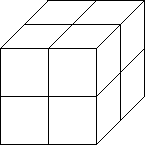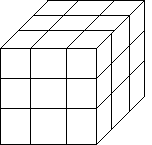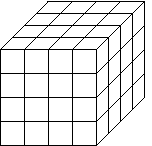Starting
with a line segment of length one, we can scale the segment by
We need three segments scaled by
Note that
In general, representing the scale by r and the number of segments of scale r by N(r) we have the relationship
N(r) = 1/r.
| Scaled by 1/2 | Scaled by 1/3 | Scaled by 1/4 |
To cover a square of side length 1 we need 4 copies of the square
scaled by
Similarly we need 9 squares scaled by
Note that
In general,
N(r) = (1/r)2.
 |
 |
 |
| Scaled by 1/2 | Scaled by 1/3 | Scaled by 1/4 |
To cover a cube of side length 1 we need 8 copies of the cube
scaled by
Similarly we need 27 cubes scaled by
Note that
In general,
N(r) = (1/r)3.
 |
 |
 |
| Scaled by 1/2 | Scaled by 1/3 | Scaled by 1/4 |
Return to Background.